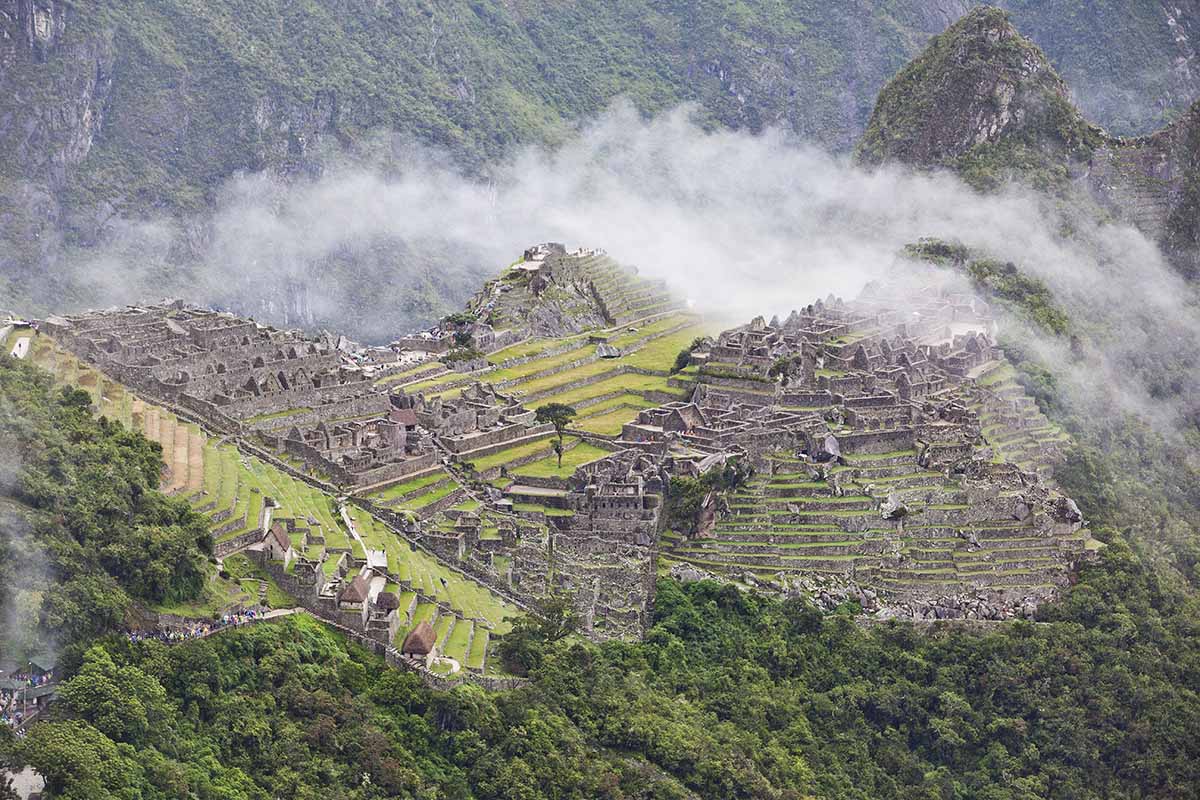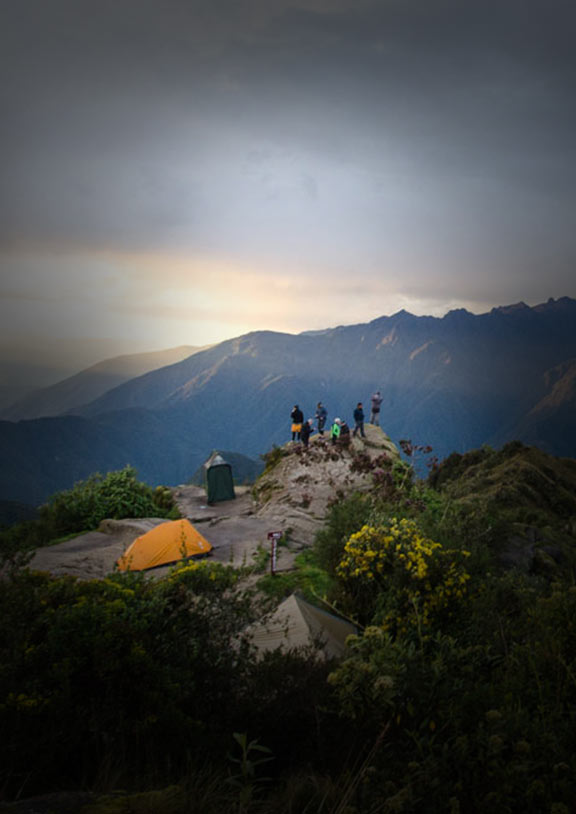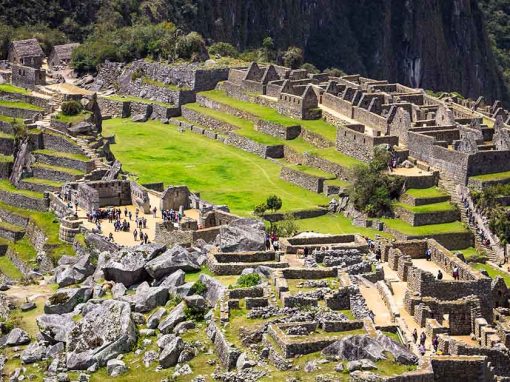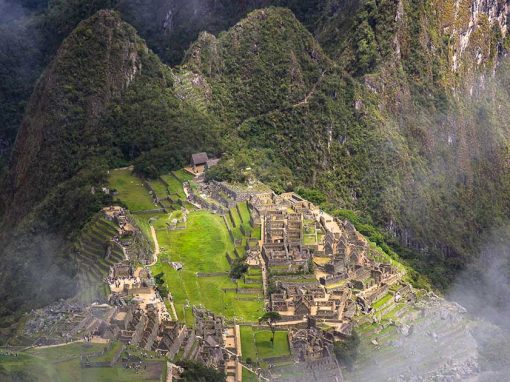The ancient Inca city of Machu Picchu, located just 4 hours from Cusco, is one of the most photographed destinations in the world. This famous mountain in Peru is known for spectacular vistas, Instagram-worthy shots and historic ruins like no other. Follow our Machu Picchu photography guide and learn how to take the best photos of these incredible ruins in Peru.
- The Best Viewpoints
- Types of Shots
- Machu Picchu Photography Packing List
- The Best Light
- Avoiding Crowds
- Weather in Machu Picchu
- Machu Picchu Regulations
The Best Viewpoints
When arriving at Machu Picchu, you may be somewhat overwhelmed by the amount of places to take pictures from. Not to mention the sheer beauty of the site itself. You may also be wondering where to get the best pictures of Machu Picchu. Planning out your route ahead of time will help save valuable time and energy so you can fit in as many locations as possible during your visit and achieve the best Machu Picchu photography!
The Classic Shot

The classic “postcard” shot of Machu Picchu taken from the Guardian House.
This quintessential viewpoint is easy to spot by the line of tourists waiting next to the thatched hut of the Guardian House to take selfies. With a small flat rock for you to sit on, think about having someone take your picture here, so you have a nice photo memory. A lot of the guided tours will stop here so people have a chance to grab their “postcard shot” with Machu Picchu, so you may have to wait a few minutes. However, this is the perfect time to prep your settings on your camera and take a few test shots while you wait. Make sure to have your wide-angle lens prepped and ready as this is an ideal focal length to capture the sweeping landscape and ruins. Check out the classic shot viewpoint here.
The Terraces

The view of Machu Picchu from the terraces, just a few steps from the Guardian House. Photo by Adriana Proano
If you like Inca terraces, then this spot is for you. Not only is this viewpoint relatively easy to get to (just a few steps from the classic shot), but it is also less busy with tourists, so you have a bit more time to play around with your shots. Arguably, this is also the more beautiful capture of Machu Picchu — especially if you have nice light. Keep your wide angle lens out for this one as well. To see what this view looks like, click here.
The Sun Gate

The view of Machu Picchu taken on the way to the Sun Gate. Photo by Peru For Less
Hiking to the Sun Gate from Machu Picchu takes an hour, so try to get there early to knock this off your list. Or, if you’d rather save some time, you can just hike halfway and still get a solid shot. Try using both your wide angle and your zoom lens to get a better variety. For the Sun Gate vantage point, click here.
Huayna Picchu Summit

The view of Machu Picchu from the Huayna Picchu summit. Photo by Peru For Less
The view from Huayna Picchu peak is unbeatable. This mountain sits across from the ruins and up a very steep climb. Make sure you have the correct ticket to be able to enter the hike (more on that below). If you plan on climbing Huayna Picchu, definitely pack light and prep your camera before the main vantage point. Check out the view here.
Machu Picchu Mountain Summit

The view of Machu Picchu from the Machu Picchu Mountain summit. Photo by Lizzie Thomas
If you are as interested in hiking as you are in taking photos, then Machu Picchu Mountain is a good choice. This hike is an investment (around 4 hours round trip) and requires a lot of time and energy. If you are up for the challenge, you’ll reach the highest vantage point in all of Machu Picchu. However, this will cut in to your photo time, so make sure you’ve planned out your time accordingly or split your time into 2 days. For the panoramic view, click here.

A map highlighting the best viewpoints for taking photos within Machu Picchu. Also, the routes and points of interest are included to help you plan your walk. Map by Peru For Less.
Types of Shots
The number one thing to remember while photographing Machu Picchu is to shoot what you like. Don’t dwell on what others will think — stay true to your own style. No two images of Machu Picchu are the same because everyone has their own unique perspective.
- Wide shots: Most of your photos will be wide-angle landscape style. Try to incorporate as much as possible including mountains, ruins, the Urubamba River below and the sky above. These shots work well to create drama and the “wow” factor.
- Detail shots: All of the Machu Picchu images that you’ve seen will most likely be wide shots, so try to vary your shots with the details. Capture the Inca ruins with the stone steps, shapes of the stones and general architecture. You can also grab shots of the Inca temples including the Temple of the Sun, the Temple of the Three Windows and the Temple of the Condor. The Machu Picchu stonework is famous for a reason, so don’t ignore it!
- Depth of field: For a more creative approach, try framing your photos with colorful foliage in the foreground. Or aim your camera through the windows or doorways in the ruins to spotlight the stonework. This is best achieved at a lower aperture (f/3 or lower) to create that framing blur and the subject sharpness.
- Llama selfie: In Machu Picchu, about 30 llamas roam freely. Take advantage of this and get one of the best shots (or at least one of the most memorable) and grab a selfie with one of the furry friends! Not feeling the selfie? Frame your photo instead to feature them in the foreground.

A tourist taking a selfie with a llama in Machu Picchu. Photo by Daniella Beccaria
For even more ideas for your Machu Picchu pictures, check out our traveler’s guide to Machu Picchu sights.
Machu Picchu Photography Packing List
When packing for your trip to Machu Picchu, keep it light. You will be walking (or hiking) in elevation and having a heavy pack will only slow you down. Here’s our recommended gear list to make your photo trip a successful one:
What to Bring
- Camera: (digital preferred, point-and-shoot or phone camera okay too!)
- Wide lens: (16-35mm / 20-28mm / 24-108mm) All of these work great but aim for a wider lens if you have a cropped sensor
- Zoom lens: (200-300mm maximum focal length)
- Polarizing lens filter: This is helpful if you have harsh sunlight
- Extra batteries: Bring them charged and ready!
- Extra SD cards: Just in case one decides to stop working
- Rain poncho
- Camera rain sleeve
- Backpack: No larger than 40x35x20cm
- Water: At least 1 liter
What NOT to Bring
- Tripod: These are not allowed (and even the smaller ones are unnecessary)
- Drone: Also not allowed
- Multiple camera bodies: Anything that makes you appear overly professional may mean you will be stopped at the gate and made to pay a fee. One camera body is sufficient and easier to carry.
- Props: They only add to making you look professional and they’re not really necessary. Let the ruins speak for themselves and keep your focus on your Machu Picchu photography
The Best Light

Machu Picchu lit up by the golden light of sunset. Photo by audrey_sel on Flickr
No one has complete control over the light they shoot in, but you can help your odds by aiming for certain times of the day. Most Machu Picchu photographs show that beautiful rich color created by either the sunrise or sunset. If you are aiming for the sunrise, the earliest you can enter Machu Picchu is 6am, so make sure you check the sunrise times before you purchase your ticket. Capturing the sunrise light can be extremely difficult due to cloudy/misty mornings and the chance of rain.
For this reason, we recommend aiming for the sunset or anytime after 3pm. If you purchase a general afternoon ticket (or one of the hike tickets to allow you time in the afternoon) you will have a better chance for clear skies and illuminating light. This will give you the best depth of color and texture for a higher impact.
Avoiding Crowds

A creative shot of the famous Machu Picchu stonework with no people around. Photo by Lizzie Thomas.
With over 1 million tourists visiting Machu Picchu annually, avoiding the crowds can be a tricky feat. You do have a few options to give you an advantage in your Machu Picchu photography adventure:
- Go as early as possible: Many of the people who go early in the morning will be starting a hike, so if you have the 6am ticket, you will be less-likely to be surrounded by crowds. Contrarily, if you do decide to do one of the hikes, you should go as early as possible so you have more time in the main ruins.
- Go late in the day: Mid-morning and early afternoon are packed with people, so try the late afternoon.
- Go in the off season: October-February usually sees less visitors, but be warned, this is also Peru’s rainy season.
- Be patient: Whenever you decide to go, you will inevitably run into people, so be patient and allow yourself enough time.
Weather in Machu Picchu
Weather in Machu Picchu is unpredictable — even when you’ve planned out the perfect itinerary and checked the forecast a thousand times — you can never predict perfect weather, especially at high elevation. With this in mind, you should come prepared for everything: rain, sun, wind, etc.
Our best advice would be to plan your trip according to the best weather, and if the rain still comes, go with the flow. Some of the most beautiful photos of Machu Picchu are on rainy days when the mist and the fog create that mysterious and magical moment in the ruins. However, if you’re feeling a bit nervous about it, check out the best time to visit Machu Picchu.
Machu Picchu Regulations
When visiting this ancient citadel, remember that you are walking into preserved Inca history. Treat this sanctuary like you would treat a museum — stay on marked paths, do not climb on the ruins and do not move any stones from their place. Seeking out the best Machu Picchu photography does not mean you have the right to break the rules.
Machu Picchu has its own list of regulations of what you can and cannot bring/do. To make it easy for you, we continually update this regulations overview outlining all the current regulations, so make sure to read up on the rules before you go.
Happy Photographing!
We hope you enjoyed this Machu Picchu Photography Guide. Now that you’re equipped with the best tips on how to photograph Machu Picchu, start planning your adventure! Learn more about Machu Picchu with our Machu Picchu Destination Guide and connect with one of our Travel Advisors to customize your trip and create the best photo experience!

Daniella was born in the sunny beach town of Santa Cruz, California. She spent her youth there before moving to Washington state to pursue a degree in journalism, photography and Spanish. She has worked professionally as a photojournalist in Seattle photographing everything from protests and political rallies to music festivals and Machu Picchu. After moving to Peru in 2018, she fell in love with the people and culture and decided to stay in Cusco where she now works with Peru For Less.









